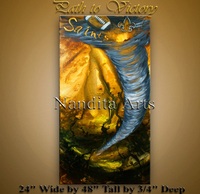What is Abstract Art?
We have all been to museums, luncheons at posh houses and few woody allen quotes, with the occasional discussion about “abstract art” creeping in. For the uninitiated, it might seem intriguing and mysterious, but fret not, its none that hard to fathom.
So what do folks really mean by this mysterious phrase? As a novice in the art scene, i had to deal with my fair share of embarrassing questions and lingering doubts, but with this post, i intend to clear any queries you might have about this intriguing subject.
Abstract artists deal with images portraying escape from reality.
It doesn’t necessarily imply an object, man or object from this plane of reality or existence. Paintings and sculptures that trigger emotions with their shapes, brushstrokes and sizes can be labelled “Abstract”.
Here’s 300 years of abstract art history crunched into simple digestible briefs- with its fair share of omissions:
1- Realism

“Envoys of Agamemnon” by Ingress
Until the late 19th century, visual art thrived on religious dogma, commissioned portraits and historical commemorations of fabulous victories or humiliating defeats. So artists sought out to recreate the moment of time they were commissioned to portray on the canvas and often minimise their individual signatures, provided they did not interfere with the essence of the story. It was at the dawn of the modern era that artisans decided to shift from realistic art and inch closer to fantasy.
2- Impressionism

When an unknown artist chided Claude Monet’s creations as mere “impressions” of a sunrise portraiture, he probably wouldn’t have realised that this coinage would launch a massive reformation of arts and transform it into a new age, at least not as he knew it. Renoir, Seurat and Degas took Impressionism further by focusing on lights, perspective on the scene being drawn and the time its taken rather than its absolute copy.
3- Expressionism

Early 20th century sparked a new revolution in modern art. Expressionism began in Germany with breakaway artists such as Edvard Munch, Paul Klee and Marc Chagall who sought to diverse their trade by infusing human emotions into their portrayal of reality. Thus, expressionistic paintings tend to depict the deep-rooted mindset of the artist and often inconsistent with reality.
4- Surrealism

If Germany was the birthplace of Expressionism, then France was the launchpad of the Surrealists. Artists under the leadership of Andre Breton sought to drift away from conventional portraiture and rather resort to unnerving and often illogical scene stitched together in pristine photographic precision. They toyed with the element of taking the viewer by surprise and unexpected juxtapositions with fabulous creations such as the reformation movements preceding them.
Which winds up to the present artistic era,
Our modern day artistic trends is an amalgamation of the previous reformation styles and their influences on individual artists. As its still a developing cause, we defy categorisation (at least for the moment). From classic oil paintings, to more surrealistic or expressionist elaborate canvas, we continue to carry forth the baton that has been passed over for generations across time and space.
The next time you bump into an abstract painting, i recommend stepping into the artist’s shoes. He’s bound to have hidden a mysterious, hidden message within his signature and would love to hear what it signifies to you. Click here to take a walk down the digital gallery of my abstract collections (and many more!) I’d love to hear your opinions.










Leave a reply
You must be logged in to post a comment.